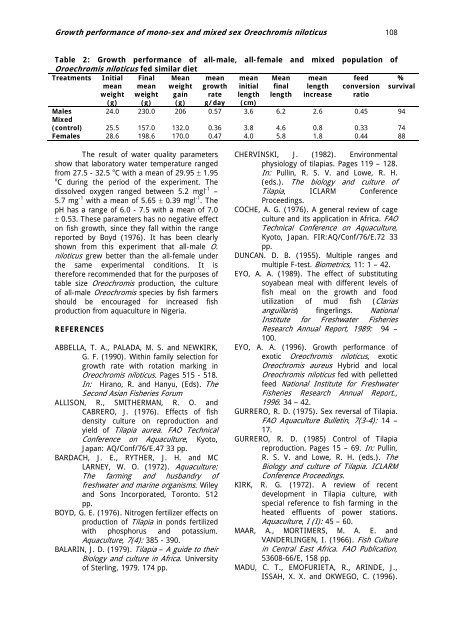ARI Volume 1 Number 2.pdf - Zoology and Environmental Biology ...
ARI Volume 1 Number 2.pdf - Zoology and Environmental Biology ...
ARI Volume 1 Number 2.pdf - Zoology and Environmental Biology ...
Create successful ePaper yourself
Turn your PDF publications into a flip-book with our unique Google optimized e-Paper software.
Growth performance of mono-sex <strong>and</strong> mixed sex Oreochromis niloticus<br />
Table 2: Growth performance of all-male, all-female <strong>and</strong> mixed population of<br />
Oroechromis niloticus fed similar diet<br />
Treatments Initial Final Mean mean mean Mean mean feed %<br />
mean mean weight growth initial final length conversion survival<br />
weight weight gain rate length length increase ratio<br />
(g) (g) (g) g/day (cm)<br />
Males<br />
Mixed<br />
24.0 230.0 206 0.57 3.6 6.2 2.6 0.45 94<br />
(control) 25.5 157.0 132.0 0.36 3.8 4.6 0.8 0.33 74<br />
Females 28.6 198.6 170.0 0.47 4.0 5.8 1.8 0.44 88<br />
The result of water quality parameters<br />
show that laboratory water temperature ranged<br />
from 27.5 - 32.5 o C with a mean of 29.95 ± 1.95<br />
o C during the period of the experiment. The<br />
dissolved oxygen ranged between 5.2 mgl -1 –<br />
5.7 mg -1 with a mean of 5.65 ± 0.39 mgl -1 . The<br />
pH has a range of 6.0 - 7.5 with a mean of 7.0<br />
± 0.53. These parameters has no negative effect<br />
on fish growth, since they fall within the range<br />
reported by Boyd (1976). It has been clearly<br />
shown from this experiment that all-male O.<br />
niloticus grew better than the all-female under<br />
the same experimental conditions. It is<br />
therefore recommended that for the purposes of<br />
table size Oreochromis production, the culture<br />
of all-male Oreochromis species by fish farmers<br />
should be encouraged for increased fish<br />
production from aquaculture in Nigeria.<br />
REFERENCES<br />
ABBELLA, T. A., PALADA, M. S. <strong>and</strong> NEWKIRK,<br />
G. F. (1990). Within family selection for<br />
growth rate with rotation marking in<br />
Oreochromis niloticus. Pages 515 - 518.<br />
In: Hirano, R. <strong>and</strong> Hanyu, (Eds). The<br />
Second Asian Fisheries Forum<br />
ALLISON, R., SMITHERMAN, R. O. <strong>and</strong><br />
CABRERO, J. (1976). Effects of fish<br />
density culture on reproduction <strong>and</strong><br />
yield of Tilapia aurea. FAO Technical<br />
Conference on Aquaculture, Kyoto,<br />
Japan: AQ/Conf/76/E.47 33 pp.<br />
BARDACH, J. E., RYTHER, J. H. <strong>and</strong> MC<br />
LARNEY, W. O. (1972). Aquaculture:<br />
The farming <strong>and</strong> husb<strong>and</strong>ry of<br />
freshwater <strong>and</strong> marine organisms. Wiley<br />
<strong>and</strong> Sons Incorporated, Toronto. 512<br />
pp.<br />
BOYD, G. E. (1976). Nitrogen fertilizer effects on<br />
production of Tilapia in ponds fertilized<br />
with phosphorus <strong>and</strong> potassium.<br />
Aquaculture, 7(4): 385 - 390.<br />
BAL<strong>ARI</strong>N, J. D. (1979). Tilapia – A guide to their<br />
<strong>Biology</strong> <strong>and</strong> culture in Africa. University<br />
of Sterling, 1979. 174 pp.<br />
108<br />
CHERVINSKI, J. (1982). <strong>Environmental</strong><br />
physiology of tilapias. Pages 119 – 128.<br />
In: Pullin, R. S. V. <strong>and</strong> Lowe, R. H.<br />
(eds.). The biology <strong>and</strong> culture o f<br />
Tilapia, ICLARM Conference<br />
Proceedings.<br />
COCHE, A. G. (1976). A general review of cage<br />
culture <strong>and</strong> its application in Africa. FAO<br />
Technical Conference on Aquaculture,<br />
Kyoto, Japan. FIR:AQ/Conf/76/E.72 33<br />
pp.<br />
DUNCAN. D. B. (1955). Multiple ranges <strong>and</strong><br />
multiple F-test. Biometrics, 11: 1 – 42.<br />
EYO, A. A. (1989). The effect of substituting<br />
soyabean meal with different levels of<br />
fish meal on the growth <strong>and</strong> food<br />
utilization of mud fish (Clarias<br />
anguillaris) fingerlings. National<br />
Institute for Freshwater Fisheries<br />
Research Annual Report, 1989: 94 –<br />
100.<br />
EYO, A. A. (1996). Growth performance of<br />
exotic Oreochromis niloticus, exotic<br />
Oreochromis aureus Hybrid <strong>and</strong> local<br />
Oreochromis niloticus fed with pelletted<br />
feed National Institute for Freshwater<br />
Fisheries Research Annual Report.,<br />
1996: 34 – 42.<br />
GURRERO, R. D. (1975). Sex reversal of Tilapia.<br />
FAO Aquaculture Bulletin, 7(3-4): 14 –<br />
17.<br />
GURRERO, R. D. (1985) Control of Tilapia<br />
reproduction. Pages 15 – 69. In: Pullin,<br />
R. S. V. <strong>and</strong> Lowe, R. H. (eds.). The<br />
<strong>Biology</strong> <strong>and</strong> culture of Tilapia. ICLARM<br />
Conference Proceedings. KIRK, R. G. (1972). A review of recent<br />
development in Tilapia culture, with<br />
special reference to fish farming in the<br />
heated effluents of power stations.<br />
Aquaculture, I (I): 45 – 60.<br />
MAAR, A., MORTIMERS, M. A. E. <strong>and</strong><br />
VANDERLINGEN, I. (1966). Fish Culture in Central East Africa. FAO Publication,<br />
53608-66/E, 158 pp.<br />
MADU, C. T., EMOFURIETA, R., <strong>ARI</strong>NDE, J.,<br />
ISSAH, X. X. <strong>and</strong> OKWEGO, C. (1996).

















